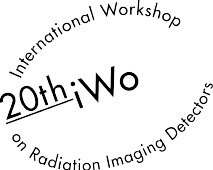Speaker
Description
Hybrid pixel detectors using high-Z semiconductors can provide a combination of efficient hard X-ray detection, low noise, fast readout and additional features such as energy binning. This is particularly important for hard X-ray experiments at synchrotron beamlines, where the high brightness can allow fast time-resolved measurements or rapid scanning of a sample. LAMBDA [1] is a photon-counting X-ray detector system based on the Medipix3 chip that was designed to provide large, tileable modules, high speed readout at 2000 fps, and compatibility with high-Z materials.
Using newly-developed 4” Cr-compensated GaAs wafers with 500 µm thickness, Tomsk State University produced a GaAs pixel array with an area of 84 mm x 28 mm, corresponding to a full LAMBDA module. The pixel size was 55µm, giving a total of 1536 x 512 pixels, and ohmic contacts were used. The sensor was bonded to 6 by 2 Medipix3 readout chips, and integrated into the readout system. Flatfield X-ray tests showed a high bump yield. Like previously-produced Cr-compensated GaAs sensors, the material shows nonuniformities with a granular structure. However, these are stable over time, and can be effectively corrected with flat-field correction to achieve a good image quality.
Large high-Z detector systems have also been built by tiling together multiple GaAs or CdTe sensors manufactured from 3” wafers, each with a 42 mm x 28 mm size. The largest systems built so far are composed of 6 GaAs sensors, giving a total active area of 84 mm x 84 mm (with gaps between modules) and a pixel count of 2.3 megapixels. These are read out by 3 sets of readout boards to allow 2000 frames per second operation. These have been used in experiments at PETRA-III synchrotron beamlines, and have demonstrated sub-ms time resolution in hard X-ray diffraction experiments.
[1] D. Pennicard, S. Smoljanin, B. Struth, H. Hirsemann, A. Fauler, M. Fiederle et al., “The LAMBDA photon-counting pixel detector and high-Z sensor development”, JINST 9 (2014), C12026
